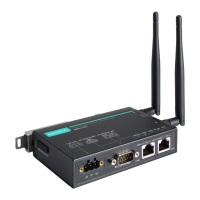AirWorks AWK-1137C Web Console Configuration
Logs and Notifications
Since industrial-grade devices are often located at the endpoints of a system, these devices will not always
know what is happening elsewhere on the network. This means that these devices, including wireless APs or
clients, must provide system maintainers with real-time alarm messages. Even when system administrators
are out of the control room for an extended period, they can still be informed of the status of devices almost
instantaneously when exceptions occur.
In addition to logging these events, the AWK-1137C supports different approaches to warn engineers
automatically, such as SNMP trap, e-mail, and relay output. It also supports two digital inputs to integrate
sensors into your system to automate alarms by email and relay output.
System Logs
System Log Event Types
Detailed information for grouped events is shown in the following table. Check the box for Enable logging to
enable the grouped events. All default values are enabled (checked). The log for system events can be seen in
Status
System Logs.
System-related events Event is triggered when…
System warm start The AWK-1137C is rebooted, such as when its settings are
changed (IP address, subnet mask, etc.).
System cold start The AWK-1137C is rebooted by power down.
Watchdog triggers reboot The AWK-1137C is rebooted by watchdog
.
Network-related events Event is triggered when…
LAN link on The LAN port is connected to a device or network.
LAN link off The port is disconnected (e.g., the cable is pulled out, or the
opposing device shuts down).
WLAN connected to AP
(for Client/Slave mode)
The AWK-1137C is associated with an AP.
WLAN disconnected
(for Client/Slave mode)
The AWK-1137C is disassociated from an AP.
Client Roaming from previous AP to
current AP (for Client/Slave mode)
A client roams from a previous AP to the current AP if the signal
strength of the current AP is greater than the previous AP by a
certain value.
IP address conflict The AWK-1137C has the same IP address as another device
connected to the same subnet.
Link fault pass-through LAN/WLAN
connected because of WLAN/LAN up
The WLAN/LAN link is up and the Link fault pass-through (LFPT)
enables the LAN/WLAN functionality.
Link fault pass-through LAN/WLAN
disconnected because of WLAN/LAN down
The WLAN/LAN link is down and the Link fault pass-through (LFPT)
disables the LAN/WLAN functionality.

